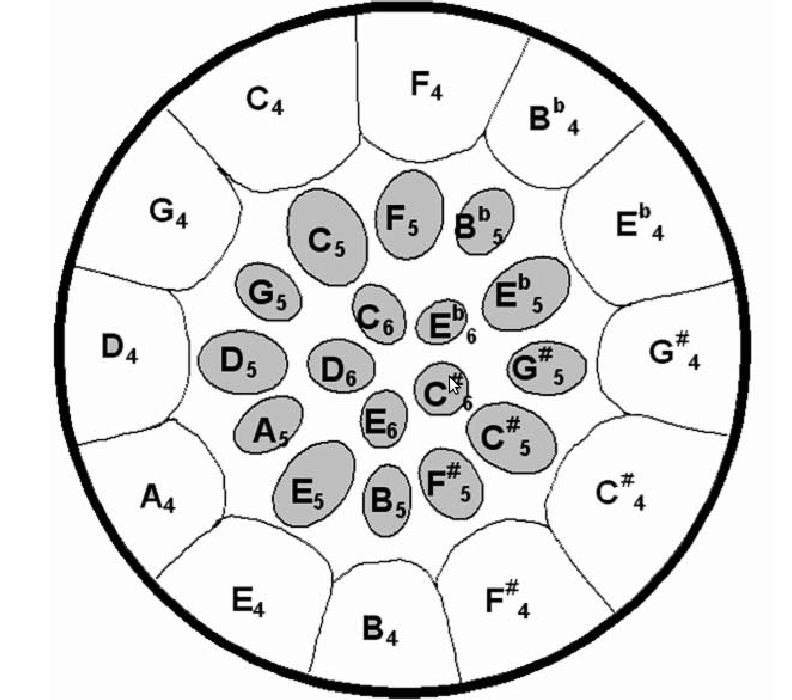Vibration Patterns of Steelpan Drums
A Citizen Science Study
 |
| A 23" Diameter is Steelpan Drum (Photo obtained from Steel Drum Source on Amazon) |
 |
| The note layout for the Kellman-tuned steelpan, the type used in this study (Photo obtained from Zooniverse) |
The steelpan drum is an instrument which originated in Trinidad and Tobago, and it is created by careful hammering on the bottom of a 55-gallon drum. One of the most defining characteristics about steelpan drums that set them apart from other instruments is the fact that all the different musical notes come from the same piece of steel. This means that, unlike many other types of instruments, the resonance and vibrations of different notes on a steelpan drum interact very differently with each other. According to Zooniverse, a common website used for citizen science studies, this citizen science study was established with the goal of learning how related vibrations propagate in different areas of the steelpan. In other words, the goal of the study is to see how different vibrations in the steelpan interact with each other.
Citizen Science Studies & The Steelpan Vibration Study
As the name would suggest, citizen science is simply science that is conducted by non-professionals. It can manifest in a virtually infinite number of ways, including through the internet. A common way that citizen science can be used is to crowdsource especially large projects. As an example, this study uses the internet to provide participants with frames showing vibration patterns of steelpan drums. As there are thousands of these frames produced every second, the scientists conducting this research are seeking to create a program that will identify, classify, and track antinodes (Garcia et al). In order to do this, participants are asked to perform this task manually, so that the data they provide can then be used to teach the program what antinodes are and how to correctly identify them (Zooniverse).
 |
| Exodus Steel Orchestra at a 2013 competition (Photo obtained from YouTube) |
Research Data
I conducted my research through the Zooniverse webpage. The webpage provided various frames showing the vibration patterns of a steel drum. Participants in this study are asked to put a green circle around each antinode as well as counting the fringes within each antinode. According to the Zooniverse webpage, an antinode is an circular spot within the image. Each antinode represents a point of resonance on the surface of the steelpan drum. The number of fringes is established by the number of smaller white concentric circles inside of the antinode. During the course of my study, I completed five frames per night for a total of seven nights. I also wrote a small explanation of what I witnessed in that image. The following five images are from 11/8.
 |
The Uniqueness of Steelpan Drums
One of the most unique aspects of steelpan drums that differentiates them from other instruments is that, although all of the notes come from the same piece of steel, the drum can still reach a wide array of tones (Zooniverse). This is in contrast to many other instruments, which often create harmonic and chromatic tones through vibration and control of various aspects of the instrument such as a string or air flow (Weinreich). The nature of the steelpan drum means that the resonance of one note can also cause resonance in others in a way that is unlike any other. According to a study published in the journal of the Proceedings of Meetings on Acoustics, "individual note areas respond when adjacent or non-adjacent musically related notes are struck and clearly illustrate the complex vibration of the steelpan." (Woods et al). The Steelpan Vibration study seeks to further this understanding into the steelpan, with the hope that understanding this unique instrument can potentially help scientists understand some of the other ways that musical resonances interact with each other in various other types of instruments (Garcia et al).
Conclusion
According to a study published in the Proceedings of Meetings on Acoustics in 2017 on the effectiveness of the crowdsourcing used in this citizen science study, the use of amateur citizen scientists is an effective method of classifying the vibration patterns of steelpan drums (Garcia et al). This is corroborated by the accounts of the study on Zooniverse, and the findings of both the study as well as Zooniverse are a good example of how and why citizen science is important. Citizen science is a great way for average, everyday people to become involved in larger scientific movements. During my own time conducting my research, I found that participating in a citizen science study is not especially time consuming, arduous, or difficult. In conclusion, I would recommend that anyone who has an interest in scientific studies, no matter how interested they are or how much previous scientific knowledge they have, try to participate in a citizen science study.
 |
| Photo of professional steelpan player Victor Provost's drum (Photo obtained from Washington Post) |
Works Cited
Garcia, Joseph Anthony & Morrison, Andrew. “Evaluating the use of crowdsourced data
classifications in an investigation of the steelpan drum.” Proceedings of Meetings
on Acoustics, Vol. 31, Issue 1, 2018.
on Acoustics, Vol. 31, Issue 1, 2018.
Weinreich, Gabriel. “Overview of musical instrument physics.” The Journal of the Acoustical
Society of America, Vol. 98, Issue 5, 1998.
Woods, Teresa & O’Malley, Patrick. “Surface Normal Measurements of Caribbean Steelpan
Vibration.” Proceedings of Meetings on Acoustics, Vol. 9, Issue 1, 2010.
Zooniverse. “Steelpan Vibrations - Research.” Zooniverse.org, www.zooniverse.org/projects/
achmorrison/steelpan-vibrations/about/research.


No comments:
Post a Comment